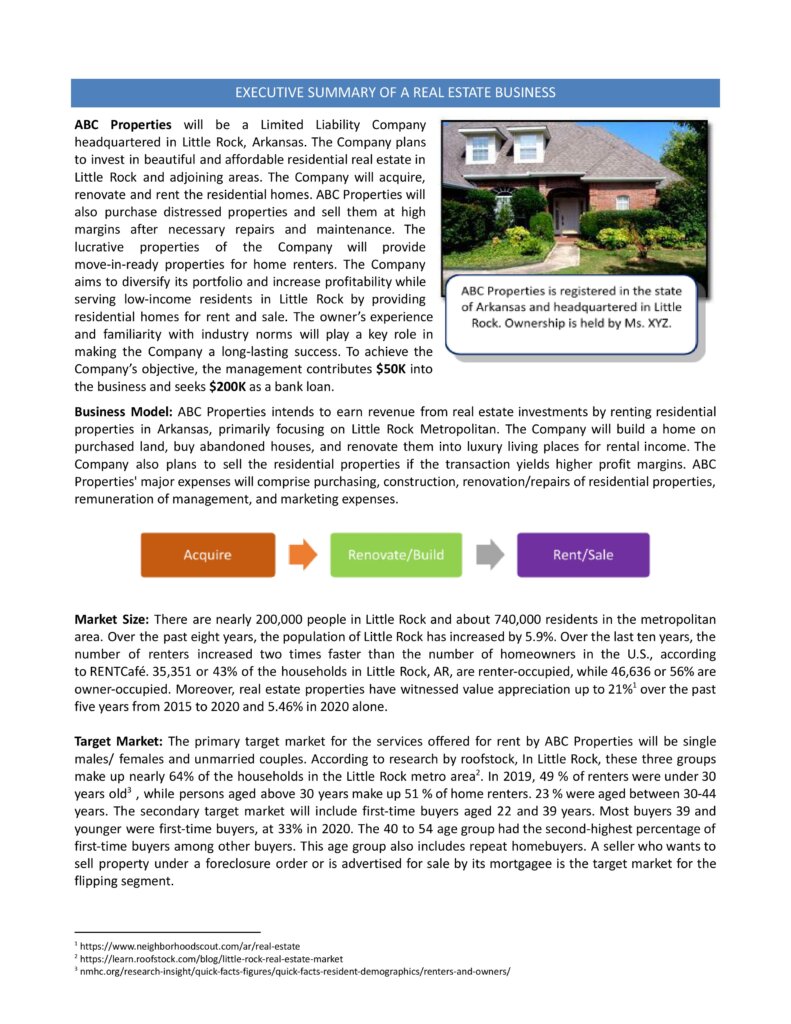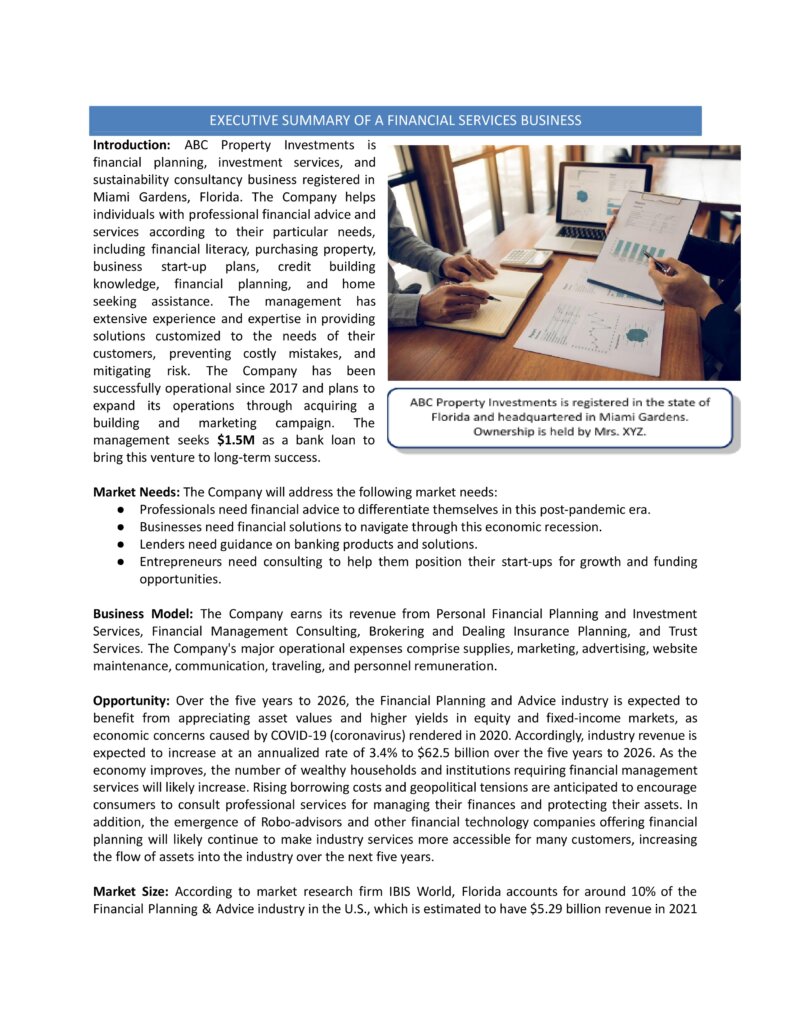- Company
- Business Plan
- Sample Business Plans
- Steps & Timeline
- Work at a Glance
- Market Research at a Glance
- Overview
- Investor Business Plan
- Bank Business Plan
- Strategic Business Plan
- Nonprofit Business Plan
- Franchise Business Plan | Business plan template ppt
- L-1 Business Plan
- E-2 Business Plan
- EB-5 Business Plan
- EB-5 Regional Centers
- Merge and Acquisition Business Plan (M&A)
- Private Placement Memorandums (PPM)
- Professional Feasibility Study
- PowerPoint Presentations
- Pitch Deck Presentation Services
- Market Research
- Plan
- Build
- Fund
- Shop
- Contact Us
- Talk to Us 1-800-496-1056
How to Write an Effective Executive Summary with Examples
Make writing your executive summary easier with these expert-vetted business plan executive summary examples
Download Business Plan Executive Summary Examples
No matter if you are presenting a business plan or an investment proposal, you need to preface your report with an executive summary. Executive summaries serve several important purposes, making them critical documents that can be challenging to write.
Executive summaries are used to introduce your project or business to investors, which is why they must be persuasive to catch their attention. The executive summary should cover your report’s major details, but you shouldn’t bore the reader with detail.
Let the report’s analysis, charts, and glowing reviews speak for themselves. During this section, you should grab your reader’s attention and tell them what you do and why they should read the rest of your business plan or proposal.
This article explains what an executive summary is, what benefits it has, what should be included, and how to write one. To help you accomplish this, we’ll show you how to write an executive summary that sets your business plan apart from the rest.

What is a Perfect Executive Summary?
The executive summary is commonly used by businesses to secure traditional funding from banks and other lenders. Effective executive summaries can quickly and persuasively convey the potential benefits of an investment and help secure capital.
An executive summary is an essence and an essential part of the business plan. It provides a short, concise, and optimistic overview of the business, aims to capture the intended stakeholders’ attention, and provides them with a thoughtful glimpse of business nature. It should describe your business, the problem it solves, your target market, and financial highlights.
The Executive Summary concise the Company’s mission and goals, how a business will start or perform its operations, and how it is looking forward to the future outlook keeping in view the market and industry trends.
Dig Deeper: How to write an effective business plan


Is it Necessary to Write an Executive Summary in Business Plan?
Executive summaries are intended to capture the reader’s attention and encourage them to read further for more information. If your executive summary provides enough value to the reader, then they might be motivated to take action without actually reading your entire business plan.
Many of the people who read business plans, including lenders, investors, and executives, simply don’t have time to read the entire document, so executive summaries let them absorb the key points and quickly assess multiple proposals at once.
How Long Should an Executive Summary be?
An executive summary should be as short as possible. You need to get your business plan across to your audience quickly since they have limited time. Ideally, your executive summary should be under 2 pages, but you can extend it if you have to.
- Introduction –draws a complete picture of the organization’s aims and objectives and how they will be achieved.
- Describe your product or service and the problem your business solves- Explain your product or service and why it is necessary. It’s not essential for your business to solve a larger social issue, but it should address a customer need or market opportunity.
- Target market – Include a clear and concise definition of your target market, as well as the need or pain point that you hope to solve.
- Competition – identifies the competition, competitive advantages, and strategies for getting market share. Do you compete on price, quality, or something else? Describe what makes your company different.
- Marketing and sales strategy – briefly outline the plans for marketing products/services.
- Financial Overview- Here you should make sales projections for the next five years after your business plan is implemented. Identify your break-even point, and inform your audience when you expect to turn a profit.
- Management – The following is a brief history of the organization, its management, staff, and partners. A potential investor wants to know who is behind the business idea and why you and your team are the best for the job.
- Funding Needs- The executive summary of your business plan should state how much money you are seeking for your business. Investors will want to know this in advance and not have to dig through a business plan for it.
- Evidence of Financial Stability- A banker will look for evidence of your financial stability, such as your net worth, assets, and financial history, when you apply for a loan.
The Executive Summary includes information about achievements, growth plans, expansion plans, and established business marketing strategies. An executive summary outlined for an established business includes:
- Business information – Gives a brief history of the business, when and where it was formed, products or services, owners and key employees, statistics such as the number of employees, and business locations.
- Business highlights – define the business’s evolution and how it has grown, including year-over-year revenue increases, profitability, increases in market share, and customer numbers.
- Financial Summary – if the purpose of updating the business plan is to seek additional financing for expansion, it gives a brief financial summary.
- Future goals – describes the goals for the business. If the business seeks financing, explain how additional funding will be used to expand the business or otherwise increase profits.
Get our proven business plan examples to help you create your plan quickly and easily.
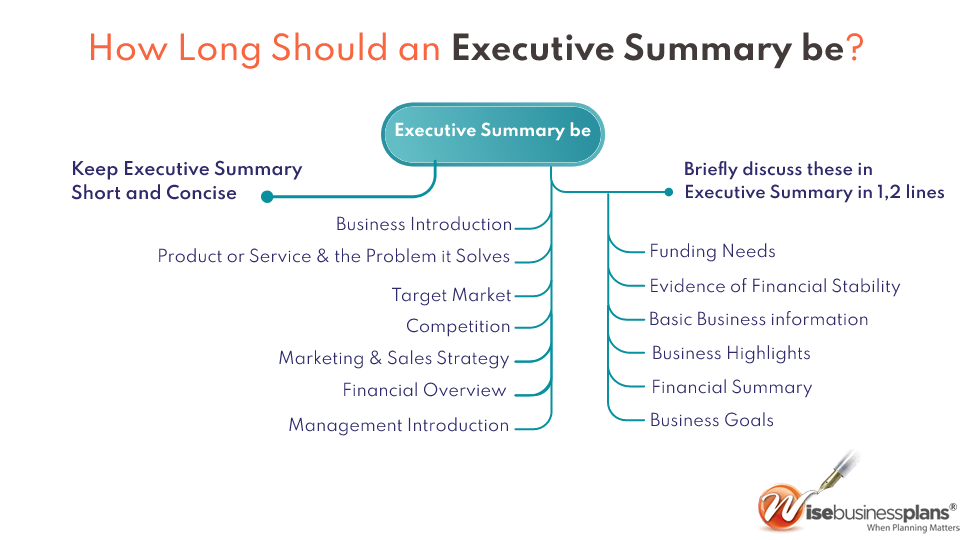
8 Tips For Writing an Effective DIY Executive Summary
Whatever your reasons for writing an executive summary are, there are a few general rules of thumb that will make it easier, and ultimately more effective. Keep these in mind as you begin:
1. Attract The Reader’s Attention.
In addition to being informative, a good executive summary should also capture the audience’s attention immediately so that they feel compelled to read the rest of the report.
It should be thorough, but it shouldn’t divulge everything. Investors should be able to read your executive summary and feel like they have a general understanding of your business concept, your abilities, and the kind of information they’ll find inside the plan,” Ferriolo said. “This is your chance to draw them in and make them want to know more.”
2. Consider Revising Your Executive Summary Until It Can Stand Alone.
It should be easy for a person without prior knowledge of your business or industry to grasp the key findings from your research, as well as the primary parts of your business plan, with a tightly informative introduction, body, and conclusion.
3. Write It Last
Your business plan shouldn’t begin with your summary. Many experienced entrepreneurs (including me) like to write an executive summary after they’ve finished their full business plan.
4. Keep Your Executive Summary Short
Keep it short and to the point. I know experts who recommend a single page, just a page or two, no more than five, and sometimes even longer. For me, less is more. Keep it concise without omitting anything essential.
5. Start Off Strong
You can capture the reader’s attention by beginning your summary with a thought-provoking statistic or a related and inspiring quote.
6. Keep A Positive Attitude
The executive summary should highlight only the positive aspects of your research and business plan. You should leave the discussion of risks, obstacles, and challenges to the body of your plan. Maintain a positive tone throughout your summary.
7. Sections Should Be Prioritized Based On Importance And Strength
The most important information should appear at the top of your executive summary. You should begin with the most important item and follow up with items in order of importance. A summary that starts with a problem often inspires drama and urgency, which tees up the solution in your business.
8. Provide Supporting Research.
Make sure you provide research to support the claims you make in the executive summary and cite this in the footnotes of a business plan.
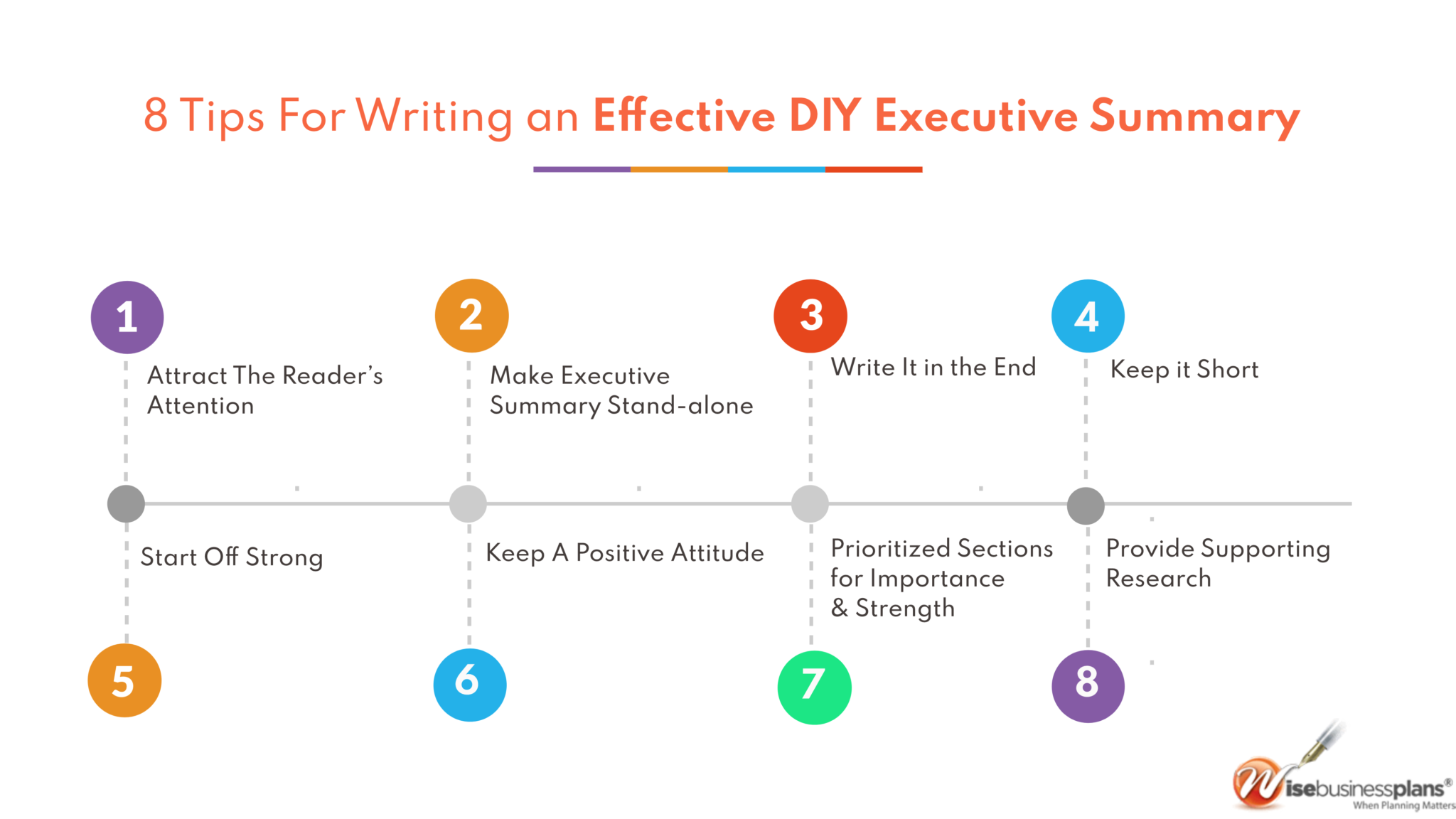

Looking for Professional Business Plan Writer
Hire our Award-winning business plan writers. We provide the highest quality services in the industry at lower rates.
How to Write an Executive Summary for a Bank Loan
As part of a loan application, a banker needs to know and understand your business in order to provide a loan, but they don’t take risks.
The executive summary must address the main points mentioned at the beginning of this article, plus a few selected points that highlight stability, assets on the balance sheet, and financial history and prove that the loan is not risky.
The banking law forbids banks from lending money to businesses that do not have enough assets to cover the full value of the loan, and then some. Bank regulations prohibit this.
Indicate Your Net Worth
A banker wants to look at the personal net worth of the owners of the firm, whereas investors want to see how much startup experience the management team has. The more collateral, money, or other investments you have, the better chance you have of obtaining the loan.
Your Financial History And Bankable Assets Should Be Transparent
In contrast to investors, bankers want to see past financial history and bankable assets. Provide every piece of financial information about yourself, current investors, and any past businesses.
Pro Tips: Learn how to write a financial plan in a business plan by pros!
Evidence Of Your Potential Stability And Longevity
Bankers want their commercial borrowers to offer future stability, instead of looking at possible exits. You don’t need exact figures, but defining growth, future cash flow, costs, and sales by year can serve as evidence of stability.
Bank Loans Are Risk-Free
Small business administrations (SBAs) in the United States work with local banks to guarantee some of the riskier small business loans, allowing small businesses to borrow money.
Traditional business plans are required for SBA loans, just as they are for bank loans. There should be an executive summary covering the five primary areas outlined in the first section.
Financial stability still needs to be described as you would for a bank. There may, however, be fewer restrictions and more funding will be available to riskier enterprises.
The executive summary is the first thing your readers will see. Moreover, if it’s poorly written, it will also be the last thing they read, as people will place your business plan aside unread.
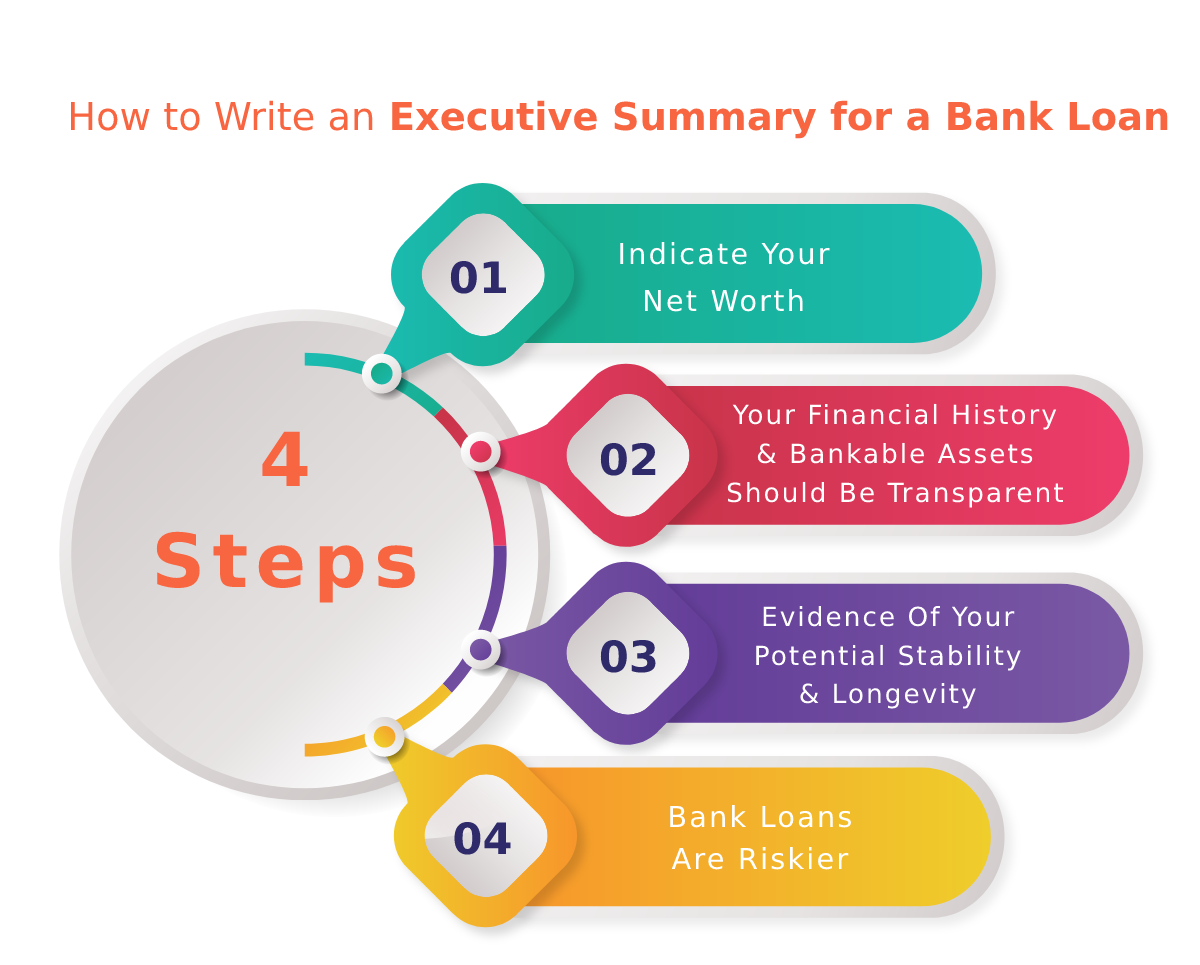
How to Revise and Perfect your Executive Summary?
You may need to revise your business plan executive summary to make sure it checks all boxes.
Business debtors and potential investors will look into your business plan executive summary. If it doesn’t catch their attention, they may put your proposal aside and don’t consider you for the loan or investment.
You can improve and perfect your business plan executive summary by following these simple steps.
Note the Important Points of the Executive Summary
You will start by reading your existing executive summary. The point is to note all the important points of your executive summary. You will write the headings as well as the description for each heading in only one sentence.
When you note only the important points, it will force you to rethink your executive summary. As an executive summary works as a preface to your business plan, you’ll see how effectively your executive summary presents your business plan. This exercise will deepen your understanding and improve your presentation.
Rewrite using the above Important Points
Let’s get back to the grind and rewrite the executive summary.
Use the notes you made in the last step. Expand the headings of the executive summary using those notes.
These are the headings you’ll use in the executive summary.
- Introduction to the Executive Summary
- Product or Service
- Target Market
- Competition
- Marketing Strategy
- Financial Overview
- Management Plan
- Funding Needs
Don’t look at your existing business plan executive summary. A fresh executive summary based on the points taken from the existing one is the goal of this exercise.
Read it Loud
Once you have rewritten the business plan executive summary, read it aloud to hear how it sounds. Involving more of your sensory system helps you understand the text better. Also, reading a text aloud helps you notice flaws you might think didn’t exist.
Use a Beta Reader
A beta reader is anyone who has some knowledge of the topic and an interest in reading it for you.
A beta reader can tell you if your business plan executive summary presents your business plan accurately and correctly and if it sounds convincing.
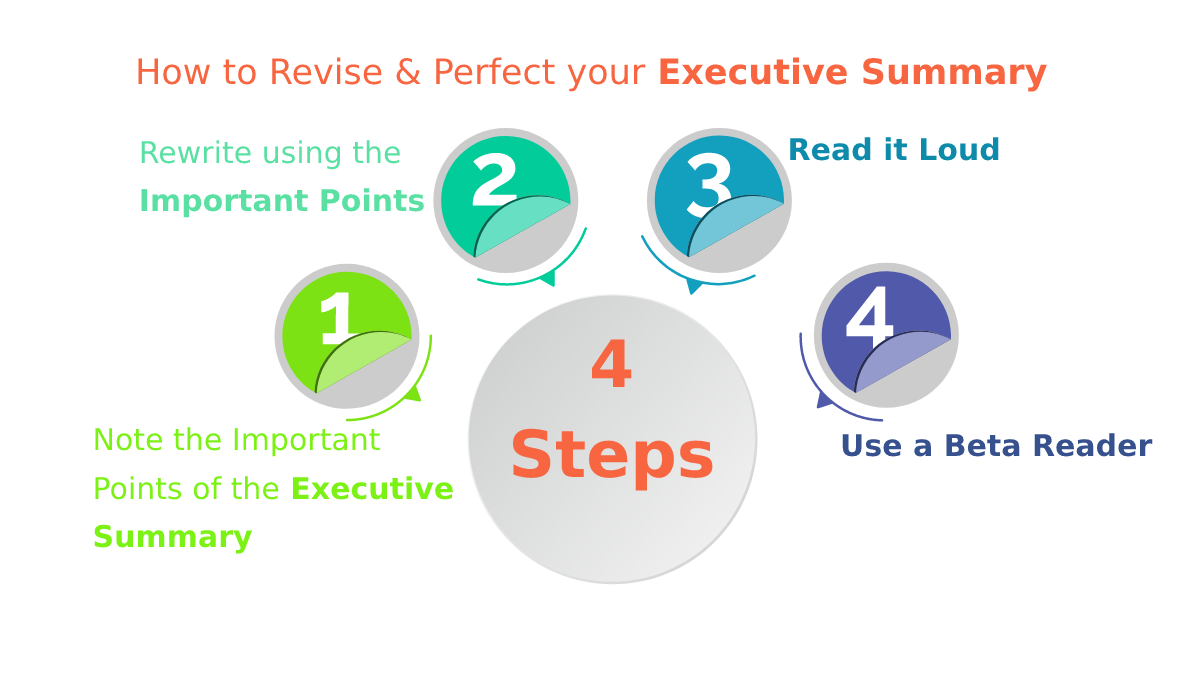
Explore More Business Plan Executive Summary Examples
Use Wise Business Plans‘ diverse collection of free business plan examples to find the one that fits your company’s profile, and use the free executive summary examples as inspiration for your own.
You can also download our 300+ free business plan templates covering a wide range of industries.
FAQs About Executive Summary Examples
Helpful Resources
- Business Planning
- Bank Business Plan
- Investor Business Plans
- Franchise Business Plan
- Cannabis Business Plan
- Strategic Business Plan
- M&A Business Plan
- Private Placement
- Feasibility Study
- Pitch Deck
- Pitch Deck
- Market Research
- Sample Business Plans
- Hire a Business Plan Writer
- Business Plan Printing
- Business Valuation Calculator
- Business Plan Examples
- Real Estate Business Plan
- Business Plan Template
- Business Plan Pricing Guide
- Nonprofit Business Plan
- Business Plan Makeover
- Business Funding
- Business E-learning Series
- Business Assets

Proud Sponsor of
- 1-800-496-1056

- (613) 800-0227

- +44 (1549) 409190

- +61 (2) 72510077

© Wise Business Plans®. All rights reserved.


